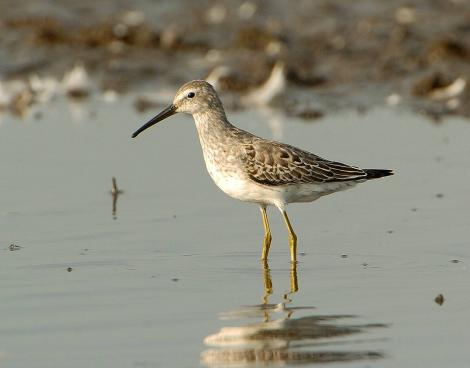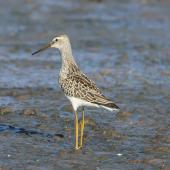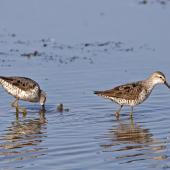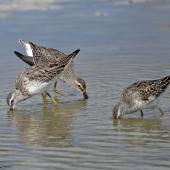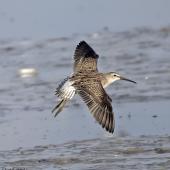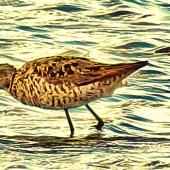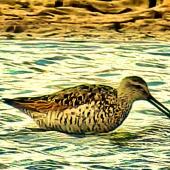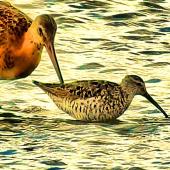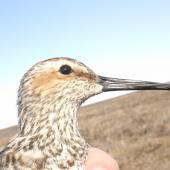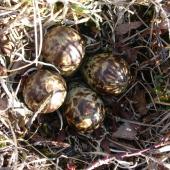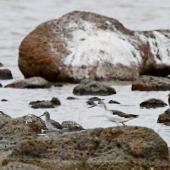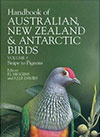Stilt sandpiper
Calidris himantopus (Bonaparte, 1826)
Order: Charadriiformes
Family: Scolopacidae
Geographical variation: Nil
The stilt sandpiper is much like most other calidridine sandpipers. It has typical sandpiper morphology and structure (e.g., long bill, long legs, and pointed wings), and both its juvenile and adult plumages are similar to the other Calidris sandpipers. Even behaviourally it is a conventional sandpiper - it is a gregarious, long distant migrant. On the Arctic breeding grounds male stilt sandpipers conduct acrobatic aerial territorial displays, a behaviour observed in many other sandpipers (e.g., dunlin, and least, semipalmated and western sandpipers). However, recent genetic evidence suggests that the stilt sandpiper does not belong to the genus Calidris, but rather it is a close relative.
Identification
The stilt sandpiper is a medium-sized wader. In non-breeding plumage, it has brown-grey upperparts (head, neck, mantle, wings), grey sides that smudge into a whitish belly, a white rump and grey tail. It also has a distinctive whitish supercilium (eyebrow) and no wing bars. The dark-coloured bill is long relative to its body size and it has a slight downward curve. The long legs can be various shades of green, juveniles have legs that tend to be yellowy-green.
Voice: when flushed the stilt sandpiper gives a repeated chyurt call.
Similar species: the downward curvature of the bill could lead to confusion with curlew sandpipers and some subspecies of dunlin (e.g., C. alpina pacifica), but the stilt sandpiper has long, greenish legs, while both the curlew sandpiper and dunlin have black legs. Under poor lighting, the yellowy-green legs of a juvenile stilt sandpiper might lead one to think of dowitchers (Limnodromus scolopaceus or L. griseus) or yellowlegs (Tringa flavipes or T. melanoleuca) but neither group has a downward-curved bill.
Distribution and habitat
Stilt sandpipers breed in the coastal regions of western Northwest and Yukon Territories (Canada) and Northern Alaska (USA). They winter primarily in the interior of central South America (Brazil, Peru, Bolivia, Paraguay, and Argentina). There are about 5 records of stilt sandpipers from Australia.
New Zealand records
The sole New Zealand record was a single bird at Lake Ellesmere in September 1998. The bird likely travelled to New Zealand with a flock of migrating curlew sandpipers.
Behaviour and ecology
Stilt sandpipers are usually found in small mixed flocks (<22 birds) and feed in shallow waters, often with the water reaching their bellies.
Food
During the non-breeding season stilt sandpipers feed primarily on a wide variety of freshwater aquatic invertebrates, supplemented by occasional seeds.
Websites
References
Davis, C.A.; Smith, L.M. 1998. Ecology and management of migrant shorebirds in the Playa Lakes Region of Texas. Wildlife Monographs 140: 3-45.
Hayes, F.E.; Fox, J.A. 1991. Seasonality, habitat use, and flock sizes of shorebirds at the Bahía de Asunción, Paraguay. The Wilson Bulletin 103: 637-649.
Hill, C. 2006. First record of a stilt sandpiper (Micropalama himantopus) in New Zealand. Notornis 53: 320-321.
Jehl Jr., J.R. 1973. Breeding biology and systematic relationships of the stilt sandpiper. Wilson Bulletin 85: 115-147.
Klima, J.; Jehl Jr., J.R. 2020. Stilt sandpiper (Calidris himantopus), Version 1.0. The Birds of the World (A.F. Poole, Ed.). Cornell Lab of Ornithology. Ithaca, NY, USA.
Miller, E.H. 1983. The structure of aerial displays in three species of Calidridinae (Scolopacidae). Auk 100: 440-451.
Sanger. G.; Collinson, J.M.; Helbig, A.J.; Knox, A.G.; Parkin, D.T. 2004. Taxonomic recommendations for British birds: second report. Ibis 146: 153-157.
Thomas, G.H.; Wills, M.A.; Székely, T. 2004. A supertree approach to shorebird phylogeny. BMC Evolutionary Biology 4: 28.
Recommended citation
Jamieson, S.E. 2013. Stilt sandpiper. In Miskelly, C.M. (ed.) New Zealand Birds Online. www.nzbirdsonline.org.nz
Stilt sandpiper
- Breeding season
-
- Jul
- Aug
- Sep
- Oct
- Nov
- Dec
- Jan
- Feb
- Mar
- Apr
- May
- Jun
- Egg laying dates
-
- Jul
- Aug
- Sep
- Oct
- Nov
- Dec
- Jan
- Feb
- Mar
- Apr
- May
- Jun




